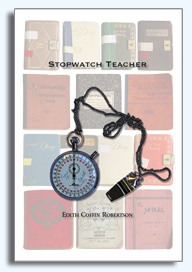Extraordinary Teaching with Stopwatch & Whistle
 PROLOGUE
PROLOGUE
Finally, I could start teaching! I had received my teaching degree in 1937. Twenty years is a long time to wait. But finally, 1957, with my youngest child Jonathan in Kindergarten, I was ready. Well, not really ready. I decided to take a few refresher classes.
“Pipe the D-A-R,” a young university gal whispered to her friend. I thought she was referring to my advanced age, calling me a Daughter of the American Revolution. Fifty-three was a bit old to be enrolled in teacher training. But no, she had meant “a damned average raiser.” Never mind. Young snippit! She’ll be fifty-three some day and she won’t think she’s too old to be important. I whizzed through that course then took a few other teacher-training courses.
Then, my first class, a fourth grade. My aim: teach the basics as prescribed by the board of education and make it fun for the kids. And how did I do that? I resolved to forget most of the college training classes. I’d do it my way. I printed my motto in capital letters in my grade book: IF THEY AIN'T LEARNED IT, I AIN'T TAUGHT IT.
I changed techniques to fit different kids. When Danny balked at folk dancing, saying he wanted to be a priest and “should not touch a woman,” I got help from his priest.
When Manuel beat me in a chess game I realized his IQ on the school records had to be wrong. We stayed after school for special coaching until he caught up.
I tried my best, year after year, to bring the kids up to grade level. What a challenge. Their reading levels as school started in September ranged from first grade to high school level. My job was to get them ready for the fifth grade. Some kids had given up. I told them, over and over, my mother had convinced the school that I should repeat the first grade. I’d remind some of the boys, “No one bats a thousand.”
I sometimes pitted girls against boys, sometimes blue eyes against brown eyes (it would be years later before I’d learn that that might not have been such a great idea), or those who had a sweetheart against those who said their mother was their sweetheart. I used the stopwatch constantly.
The kids knew they would have to write almost every day. They also knew they would sometimes be expected to stand and read to the class. I kept constantly, in the back of my mind, my husband Ray’s distress when he had to speak before a group. He resented getting through school with an A average and never learning to get up before a group. In Ray’s mind, his teachers had failed to do their jobs. From time to time, during my teaching career, Ray would ask, “Are you getting those kids up before the class?”
Yes, I was following my husband’s advice. Doing it my way, of course. On a typical writing period I might say, “Just ten minutes today. Notebook open. Pencil in hand. Eyes closed. Think of what you had for breakfast. Open eyes. Write!” Then I’d call time and tell them to count the words. They’d put the total at the end of their writing and try to do better the next time. Sometimes I’d ask for volunteers to read what they’d written, but the kids knew their writing was private; I never read what they wrote and no one had to share. Jerry stood with notebook open, only a few sentences there, glibly pretended to share what he had written, but I never called his bluff.
I tried to make them want to write. Subject matter could range from “Why I Hate Boys (Girls)” to “My Best Vacation.” One of their favorite subjects was “What I Don’t Like About Teachers.”
I made friends with the parents. I played ball with the kids. One of our favorite games on rainy days was “Screwy Louie.” We arranged the desks in two sections facing each other, and tied a rope fairly high to indicate the top of a net. The inside of an old volleyball we used was too soft to do damage as it bounced off walls and windows. The kids had to stay seated and every volley was fair unless it bounced off the ceiling. The kids quickly learned volleyball rotation as they hotly contested each point. They sometimes laughed so loud other kids would leave their own rooms where they had been playing checkers or dominos to stand at the back of our room, to watch and cheer.
It was the fourth grade teacher’s job to review adding and subtracting facts (this meant a re-teaching process) and then go on and help the kids learn the multiplication and division facts. I bought records of the facts in syncopated rhythm for the kids to sing to. We worked to have each kid master all the multiplication and division facts with 98% to 100% accuracy in a 100 item two-minute test. When each had accomplished this he’d be excused early at recess time. In addition, those who had mastered the facts were allowed to play chess on Fridays while the other kids drilled with flash cards.
I somehow knew that the standard model for teaching didn’t work; in my opinion, a teacher droning away at the front of a class of students taking notes isn’t teaching much of anything. Kids learn better when they’re active and having fun, and we all learn best through active participation.
In short, I didn’t teach the way other teachers did or even the way I’d been taught in college; I did what worked for me and my students. And when that failed (as it sometimes did), I changed my tactics. I learned as I taught, and tried not to repeat mistakes. I was unorthodox. I did it my way. ~ECR